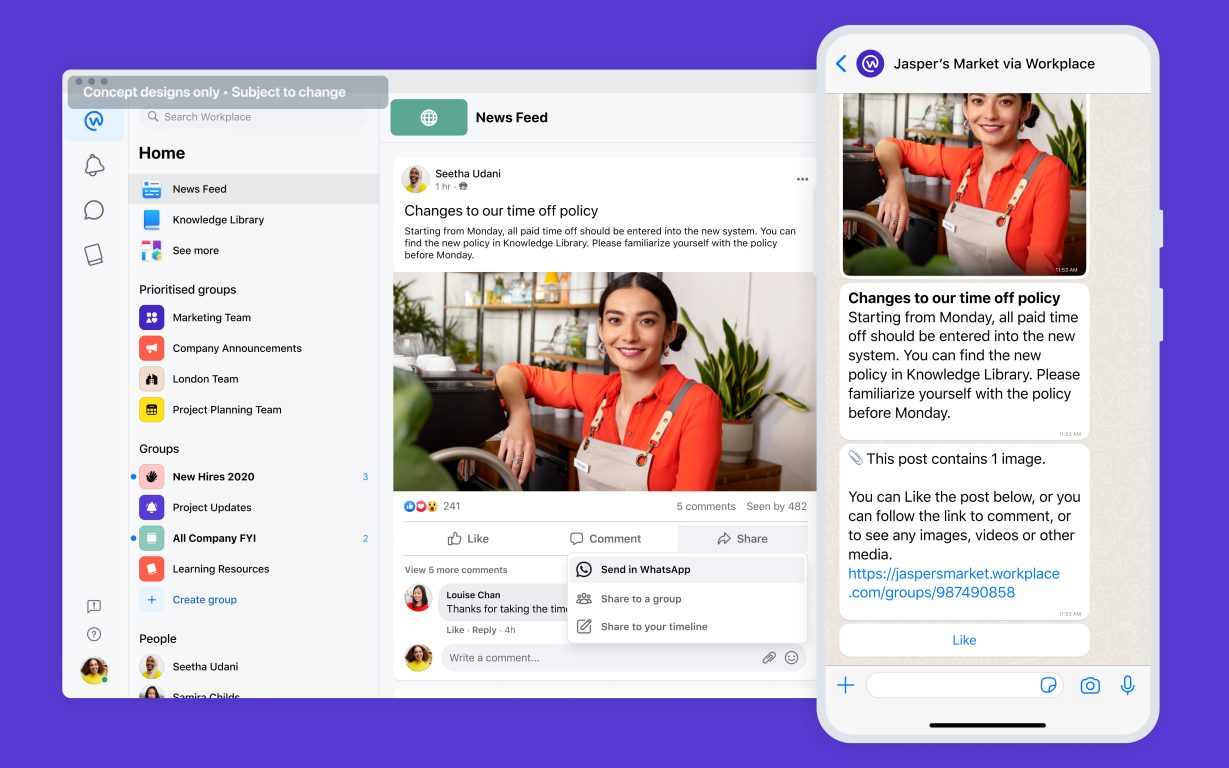52% of frontline workers to quit over tech tools
They may be deskless, but they shouldn’t be voiceless.
Why You Should Care
Frontline workers are dissatisfied, and feel disconnected from their desk-based colleagues and leadership team.
Discover data from Workplace from Meta about what frontline workers want.
Hint, better communication tools are key!
Frontline workers, such as delivery drivers, healthcare workers, and retail assistants, have been essential during the pandemic. “The pandemic has really forced awareness about how critical these workers are…and really shined a light on them,” Workplace from Meta director Christine Trodella.
Ultimately, it is encouraging that 100% of 1,350 C Suite leaders surveyed by Workplace said the frontline will be a strategic priority from now on. And 83% said the pandemic had really brought this to light.
Importantly, the frontline agrees that their profile has been rising. 29% now feel as important as their office-based colleagues, 27% said they only valued because of the pandemic, and 74% are satisfied in their role, compared to 47% a year ago.
However, C-Suite and leadership recognition of the frontline comes from a very low level – only 27% of C-Suite said the frontline had always been a priority pre-pandemic. As Trodella terms it, they were historically “out of sight, out of mind”.
In addition, just over half (55%) of 7,000 frontline employees told Workplace they feel connected to their headquarters and leadership. Couple this with seven in ten frontline workers suffering from or at risk of burnout in the past 12 months, leaders have a looming crisis on their hands.
“We’ve seen some improvement [and good intentions from the C-Suite], but we still have a long way to go”, notes Trodella.
Unpicking the ‘Great Frontline Resignation’
A major part of the challenge employers face with their frontline employees is the so-called ‘Great Frontline Resignation’.
These workers are dissatisfied and ready to vote with their feet. 57% of frontline workers told Workplace that they are ready to move into another frontline role with a better salary, while 45% are considering leaving the frontline all together.
A lack of learning and development has been offered as an explanation for the ‘Great Resignation’ trend in general. So it is further concerning that 43% of frontline workers said they have reached the limit of what they can learn at their current organization.
It is clear that leaders are not burying their heads in the sand and are aware of this trend. Almost seven in ten of 70% of C-Suite executives are expecting high attrition rates, but they are not sure how to deal with the situation.
Just 25% said they were planning to increase wages, while only 26% were planning to invest more in learning in development and one in five were actually planning to reduce professional development funding in the next year.
Is better communication tech the solution to stop resignations?

Christine Trodella, director at Workplace from Meta.
While is it essential that companies rethink their attitudes towards salaries, benefits, and learning, Trodella notes that successful attraction and retention requires companies to pay attention to “real expectations around transparency and flow of information” from workers.
“Frontline workers expect to have access to the same information as anybody else in the company,” she adds.
Tech is helpful as a solution for this, and frontline workers expressed their expectation to have access to good quality tech, like the office-based colleagues.
94% of C Suite admit they have traditionally prioritized office and desk-based tech.
This is a problem as 52% of frontline workers told Workplace access to tools was the reason they would move to a new job, and 44% of frontline workers believe desk-based colleagues have better tech.
So it is clear that investing in the right tools, and particularly good communication tech, would help companies succeed in the ongoing frontline attrition crisis.
The right tech for the frontline
The next challenge is figuring out what types of tech frontline workers want and need.
While they want to have the same quality of tech as desk-based workers – just because they are deskless, doesn’t mean they should be voiceless – the tools they rely on must be built with the frontline in mind, and particularly suit their non-9-to-5 schedules.
“They need technology that is ease to use, that is accessible on a mobile and really importantly that requires no training,” explains Trodella.
This is precisely what Workplace is trying to provide with its platform modeled on Facebook’s consumer product, which now also integrates with another Facebook product: Whatsapp.

Workplace from Meta’s integration with Whatsapp.
This helps to “remove friction” in getting tech into the hands of frontline workers, Trodella adds.
They also want tech that enables a two-way dialogue, which will help drive trust and transparency at work. Currently, one in four frontline workers do not trust their senior leadership team or their line manager to protect their wellbeing and happiness.
Having the tech is only one part of the equation, the next part is “the way it is used”, according to Trodella.
Workplace’s report notes that leaders must not communicate to workers, but with them. Trodella explains that “some of the best stories from our customers during the pandemic was how many of their CEOs would [use Workplace] to go online with video”.
Both AstraZeneca and Vodafone told UNLEASH about how they utilized these functions during the pandemic to keep employees engaged despite not working in the same place.
CEO video meetings allowed employees to ask questions and provide feedback to the C Suite. “It really made people feel more connected to the leadership” and created a “more accessible human C Suite”.
“We do see that when [companies] employ this technology, and employ behaviors that connect people, [they] get really good results”, concludes Trodella.
Now is the time for employers to invest in a new tech standard for the frontline, or risk losing talent to competitors that are putting the frontline’s needs first.
Sign up to the UNLEASH Newsletter
Get the Editor’s picks of the week delivered straight to your inbox!

Chief Reporter
Allie is an award-winning business journalist and can be reached at alexandra@unleash.ai.
